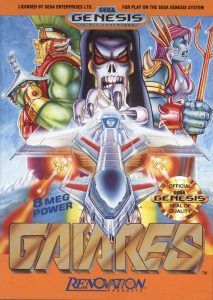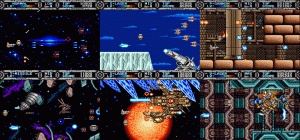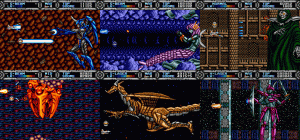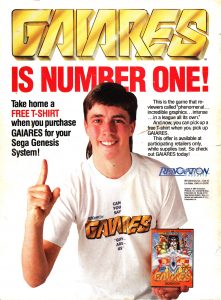In this excerpt from his forthcoming book, 100 Greatest Console Video Games: 1988–1998, author Brett Weiss examines one of the most renowned shmups on the Genesis, Renovation’s Gaiares. Weiss is the author of more than a dozen books, including the Encyclopedia of KISS. He has had articles published in numerous magazines and newspapers, including the Fort Worth Star-Telegram, Filmfax, Fangoria, AntiqueWeek, The Writer, Mystery Scene, and more.
The late 1990s was an amazing time to collect vintage video games. Retro game collecting was still a niche hobby, but I had been collecting for many years at that point. Around once a week or so I would drive around to the various FuncoLand stores in the Dallas/Fort Worth area and buy whatever NES, Genesis, and Super NES games that looked interesting and/or fun to play. The PlayStation and the Nintendo 64 were the hot systems at the time (the Dreamcast released at the tail end of the decade), and you could buy most games for previous consoles for super cheap.
 FuncoLand, which would become GameStop in 2000, was an amazing store with a huge selection from the NES forward. Unlike what would become of GameStop, which eventually dropped retro games, and which would begin selling way too many non-gaming items, FuncoLand was filled to the brim with gaming goodness (as was GameStop for the first few years). FuncoLand stocked boxes for their older games, as well as the manuals. They had room to do this since they were focused purely on video games.
FuncoLand, which would become GameStop in 2000, was an amazing store with a huge selection from the NES forward. Unlike what would become of GameStop, which eventually dropped retro games, and which would begin selling way too many non-gaming items, FuncoLand was filled to the brim with gaming goodness (as was GameStop for the first few years). FuncoLand stocked boxes for their older games, as well as the manuals. They had room to do this since they were focused purely on video games.
The FuncoLand closest to my house had a huge wall of Sega Genesis games, many of them with boxes and manuals, and this is where I bought my complete copy of Gaiares (pronounced “Guy-Are-Us”) for just $2.99. I had read in a magazine—probably Electronic Gaming Monthly—that Gaiares was a kickass side-scrolling shooter with killer weapons, excellent graphics, and super fun and challenging gameplay. Since I was a big fan of side-scrolling shooters dating all the way back to such arcade classics as Defender and Scramble (both 1981), and since I loved a bargain and collecting mint-in-box games, it was a no-brainer purchase. (Today, a boxed copy of Gaiares will set you back around $130-$150. Or $180-$200 if it includes the manual and foldout poster.)
When I brought Gaiares home and plugged it into my Genesis later that afternoon, I was not disappointed. Not in the least. I discovered that it was indeed a kickass game with all the attributes ascribed to it by the aforementioned magazine review.
The best side-scrolling shooter on a system that excels in the genre, Gaiares takes place in an alternate future where Mother Earth “has been turned into an environmental wasteland by careless humans.” Gulfer, an intergalactic terrorist group, plans to invade Earth and use the pollution as weapons. As ace pilot Dan Dare, you must take the helm of your powerful spacecraft and stop them. Ten minutes of anime cutscenes—unusually lengthy for a cartridge game—tell the story.
Gaiares is brutally difficult, but it never feels overly unfair or cheap like some of the more frustrating shooters, such as those in the “bullet-hell” subgenre. Despite how many times I get destroyed while playing the game, I always feel like if I just would have had faster reflexes or made a smarter move, I could have survived. The ship you pilot is nimble and speedy right out of the gate (you can select from three speeds at any time with the A button), the controls are perfectly responsive, the power-ups are a blast to acquire and use (Gradius fans will love them), and the action keeps you attentive and engaged every step of the way.
You guide your ship through four distinctive levels: Floating Continent, Glacial Planet, Space Sanctuary, and Space Colony. You’ll dodge asteroids and falling stalactites, pass through the tunnel of an iceberg, destroy gun turrets and laser batteries along planet surfaces, blast your way through deadly scenery and the bay doors of giant ships, cruise through space at high speeds (the backgrounds whiz by at times), get tugged at by gravity from a black hole, and pass through a graveyard of robots and spaceships. And, of course, you’ll fire away at enemy ships and creatures along the way, including huge, highly detailed bosses, such as a Grim Reaper lookalike and an armor-clad figure with shield and sword in hand. Branching pathways resulting in different obstacles and enemies add to the fun.

Click to see all the stages!
Just as your ship is immediately capable of three speeds, it is always equipped with a TOZ intelligence system device, which, at first glance, appears similar to the Force weapon in R-Type. However, instead of destroying enemies, it attaches itself to them and “teaches” your ship how to use the enemy in question’s weaponry. Learning the weapon of the same enemy repeatedly increases the power of the weapon. Said weapons include horizontal and vertical lasers, rotating bullets, multi-directional shots and missiles, a plasma cannon, homing lasers, and giga beams, which are thick lasers that launch forward. You can fire the TOZ at defense items as well, including a barrier shield and a dimension quake that destroys all onscreen enemies. The difficulty level is muted somewhat by the powerful weapons and relatively frequent availability of shields, but beating the game is still a tough challenge, thanks in part to the fact that you must make strategic use of weapon choice and speed selection.

Click to see all the bosses!
John Sczepaniak, writing for Hardcore Gaming 101, explains another reason for the game’s difficulty (not to mention its re-playability): “Enemy locations and firing patterns are not fixed but based upon player position, meaning the game constantly adapts and is almost procedurally generated. You can’t simply memorize their locations; you need to be ready to adapt with them.”
A Genesis/Megadrive exclusive, Gaiares was created primarily by programmer Masayasu Yamamoto and graphics and game designer Kouji Yokota. The music is by Shinobu Ogawa.
In The Untold History of Japanese Game Developers: Volume 1 (2014, SMG Szczepaniak), Yokota explains in an interview why the game was created to be super challenging in the first place:
Yamamoto-san, the programmer, was in charge of the game balance, but it was originally intended for the overseas market. Since there’s a tendency to play a game and then sell it, as well as rental systems, the overseas publisher, Renovation, asked us to make the game more difficult so it would not be rented and completed easily. When we went over to show them the demo they said, ‘You should make it even more difficult!’ We started getting concerned at this point, but we complied. So ultimately the game became very difficult.
 Even though Gaiares has skyrocketed in price over the past couple of decades, I’ll never sell my copy. Not only is it a great game that I come back to time and again, it’s a fun reminder of collecting during the 1990s, when “game chasing” was a cheap hobby that almost always yielded results.
Even though Gaiares has skyrocketed in price over the past couple of decades, I’ll never sell my copy. Not only is it a great game that I come back to time and again, it’s a fun reminder of collecting during the 1990s, when “game chasing” was a cheap hobby that almost always yielded results.
FUN FACT: Back when Gaiares was new in stores, participating retailers offered a free T-shirt with purchase of the game. That shirt, which shows how to pronounce the game’s name—GUY-ARE-US—is very hard to find today.
WHY IT MADE THE LIST: Gaiares covers all the bases. It’s challenging, but not frustrating. It looks and sound fantastic, thanks to colorfully detailed graphics and a rocking soundtrack. It scrolls smoothly and has excellent controls. And it features an inventive power-up system and incredibly cool weaponry. In short, it’s FREAKING AWESOME!
From: 100 Greatest Console Video Games: 1988–1998, on Kickstarter now! Head over to Brett’s site for more information on his other publications.

Recent Comments